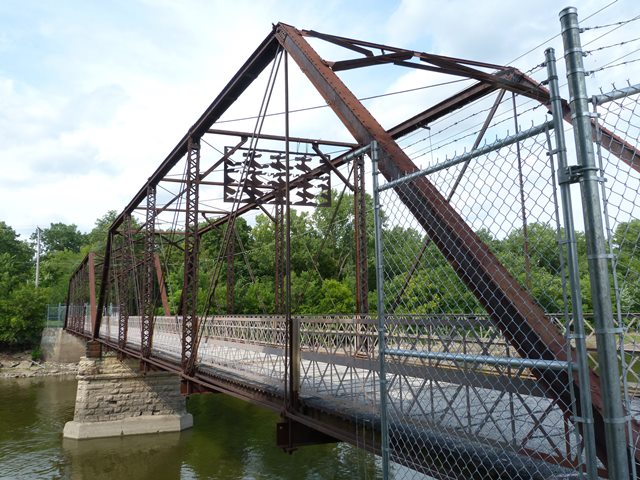We Recommend:
Bach Steel - Experts at historic truss bridge restoration.
BridgeHunter.com Phase 1 is released to the public! - Visit Now
Sylvan Island Highway Bridge
2nd Street Bridge

Primary Photographer(s): Nathan Holth
Bridge Documented: August 11, 2013
Moline: Rock Island County, Illinois: United States
1901 By Builder/Contractor: Clinton Bridge and Iron Works of Clinton, Iowa
Not Available or Not Applicable
110.0 Feet (33.5 Meters)
200.0 Feet (61 Meters)
Not Available
2 Main Span(s)
Not Applicable

View Information About HSR Ratings
Bridge Documentation
This bridge no longer exists!
Bridge Status: This historic highway bridge was demolished and replaced with a pedestrian bridge despite preservation potential to make this historic bridge serve another century!This bridge is a beautiful example of a pin-connected Pratt truss bridge. This type of bridge was the cornerstone of the late 19th Century and early 20th Century. They were once common in this country. However, surviving examples of these historically significant and beautiful truss bridges are drastically falling across the country due to demolition. This particular multi-span example is traditionally composed and a good representative example of its type. Its trusses retain historic integrity with no major alterations. One somewhat odd detail is that the northern span is slightly larger (and has one more panel) than the southern span.
This bridge was built in 1901 to provide vehicle access to Sylvan Island. It was closed in the 1960s. The island later became a park and the bridge was converted for pedestrian use in 1995.
Former Discussion of Preservation Potential
In 2013, the bridge was closed due to deterioration, which cut off public access to Sylvan Island, which was a pedestrian-only park. A news article conveying the findings of the inspection that led to the closure of this said that one of the problems was that the bridge had "bounce" to it. This rather unprofessional description appears to refer to the movement that can be expected in the normal function of ANY pin-connected truss bridges (which have flexible connections at each panel point that are like hinges). An engineer with experience with historic bridges would be more concerned if the bridge didn't have any "bounce" since that would suggest the parts had seized up, which could put too much strain on some truss members. There is significant deterioration on this bridge to be sure, notably, the deck appears to be in bad need of replacement. There also are areas of complete section loss at the ends of the struts. However, there is nothing that indicates that this bridge is not like most pin-connected truss bridges with deterioration: feasible and cost-effective to restore for pedestrian use. Apparently the engineer who was concerned about the "bounce" in this bridge also said it would cost more to restore this bridge than to replace it. This is very questionable. Often engineers unfamiliar with this bridge type add a lot of padding to their estimates because they are afraid of deterioration that will be found only once restoration begins. An engineer more familiar with this bridge type will already KNOW where additional deterioration might be hidden and will not have to pad the cost estimate as much. Moreover, hiring a fabricator like Bach Steel to do the actual restoration can save on costs too since they will provide a better end result for less money because they are aware of and know how to repair these types of bridges that are so different from modern bridges built today. HistoricBridges.org suggests that Moline seek out an engineer and fabricator with extensive historic truss bridge restoration experience. Not only may it well be possible to restore this bridge at a cost closer to that of a replacement bridge, doing so will preserve an important and beautiful historic bridge. A preserved bridge would be a pleasing landmark inviting people to walk across it and explore the park. It also conveys the past of Sylvan Island. As a former vehicular truss bridge, visitors can interpret that Sylvan Island was not always a pedestrians-only park. This interpretive ability would not be possible with a modern replacement bridge. Also, modern replacement pedestrian bridges tend to be very plain and ugly, and they all tend to look the same. Why would anyone want such a boring entrance to a park?
If Moline still insists on demolition of this bridge, there is one other possibility that would prevent the need for a hideous looking modern bridge. The nearby abandoned Sylvan Island Railroad Bridge, a nationally significant cast iron truss bridge, could be moved down here and redecked for pedestrian use. Although old, it is a massive railroad bridge with much more strength in it, plus it is made of materials like cast and wrought iron that do not deteriorate like steel does.
Above: Historical photo of bridge.
![]()
Photo Galleries and Videos: Sylvan Island Highway Bridge
Bridge Photo-Documentation
Original / Full Size PhotosA collection of overview and detail photos. This gallery offers photos in the highest available resolution and file size in a touch-friendly popup viewer.
Alternatively, Browse Without Using Viewer
![]()
Bridge Photo-Documentation
Mobile Optimized PhotosA collection of overview and detail photos. This gallery features data-friendly, fast-loading photos in a touch-friendly popup viewer.
Alternatively, Browse Without Using Viewer
![]()
Maps and Links: Sylvan Island Highway Bridge
This historic bridge has been demolished. This map is shown for reference purposes only.
Coordinates (Latitude, Longitude):
Search For Additional Bridge Listings:
Bridgehunter.com: View listed bridges within 0.5 miles (0.8 kilometers) of this bridge.
Bridgehunter.com: View listed bridges within 10 miles (16 kilometers) of this bridge.
Additional Maps:
Google Streetview (If Available)
GeoHack (Additional Links and Coordinates)
Apple Maps (Via DuckDuckGo Search)
Apple Maps (Apple devices only)
Android: Open Location In Your Map or GPS App
Flickr Gallery (Find Nearby Photos)
Wikimedia Commons (Find Nearby Photos)
Directions Via Sygic For Android
Directions Via Sygic For iOS and Android Dolphin Browser
USGS National Map (United States Only)
Historical USGS Topo Maps (United States Only)
Historic Aerials (United States Only)
CalTopo Maps (United States Only)


